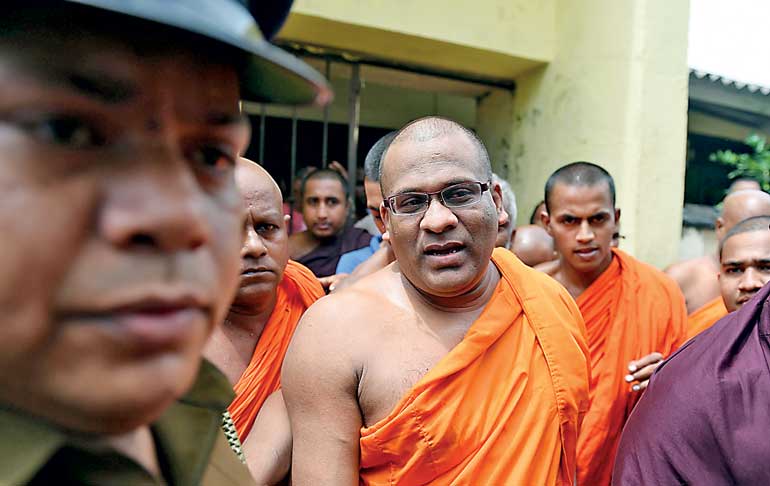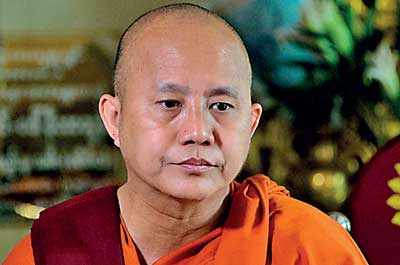Tuesday Mar 04, 2025
Tuesday Mar 04, 2025
Thursday, 15 March 2018 00:00 - - {{hitsCtrl.values.hits}}

In this file photo, taken on 21 June 2017, fugitive Buddhist monk Galagoda-Atte Gnanasara (C) arrives at a court in Colombo to surrender in response to a warrant for his arrest. Anti-Muslim riots by Buddhist mobs in Sri Lanka have left at least three dead and more than 200 Muslim-owned establishments in ruins in the last week – AFP
Hong Kong (AFP): Buddhism may be touted in the West as an inherently peaceful philosophy, but a surge in violent rhetoric from small but increasingly influential groups of hard-line monks in parts of Asia is upending the religion’s tolerant image.
Buddhist mobs in Sri Lanka last week led anti-Muslim riots that left at least three dead and more than 200 Muslim-owned establishments in ruins, in just the latest bout of communal violence there stoked by Buddhist nationalists.
In Myanmar, ultra-nationalist monks led by firebrand preacher Wirathu have poured vitriol on the country’s small Muslim population, cheering a military crackdown forcing nearly 700,000 Rohingya into Bangladesh.
And in neighbouring Thailand, a prominent monk found himself in hot water for calling on followers to burn down mosques. 
What has prompted this surge in aggressive rhetoric from followers of a faith that is so often equated, rightly or wrongly, with non-violence? For many in the West, schooled in Buddhism via the beatniks, Hollywood, meditation classes, tropical holidays and inspirational Dalai Lama quotes, the visceral response of these monks can be a shock.
But Youngstown State University religion expert Michael Jerryson, who has just completed a book exploring Buddhism and violence, says throughout history some Buddhists - like any faith - have used religion to justify violence.
“There’s a common mindset, whether it’s Sri Lanka, Myanmar, Thailand ... that Buddhism is somehow under threat,” he said, describing the latest incarnation of violent Buddhist rhetoric. “Each area has its own history, its own causes and instigators, but these instigators are also interlinked.”
Invasive Islam
In many recent cases around Asia, this aggression has been targeted toward Muslims.
After the Taliban’s destruction of the Bamiyan Buddha statues in Afghanistan and the “war on terror” rhetoric, Jerryson says, warped historical grievances have “collided with recent Islamophobia.”
Despite centuries of largely peaceful co-existence and trading, Buddhist fundamentalist groups portray Islam as invasive, toppling ancient Buddhist empires in Malaysia and Indonesia, and now threatening the same for modern Buddhist nations through jihad or high birth rates.
Myanmar’s Wirathu has built a following railing against Muslims in incendiary sermons, both in person and on Facebook, which closed down his page in January. While Muslims make up less than four percent of Myanmar’s population, Wirathu paints a millenarian portrait of an Islamic plot to eradicate Buddhism. His Ma Ba Tha group was instrumental in pushing laws to restrict interfaith marriages and changing religion.
In Sri Lanka, Buddhist militancy has gone mainstream, with clergy seen clashing with riot police and leading anti-government protests. During the brutal 26-year civil war, the ire of ultra-nationalists among the mainly Buddhist Sinhalese majority was focused on the island’s Tamil Hindus. But after the Tamil Tigers were beaten in 2009, hardliners turned on Muslims, who make up some 10 percent of the population.
Monk Galagoda-Atte Gnanasara, the movement’s most prominent leader, is on bail facing hate speech charges and insulting the Quran. “The Quran should be banned in the country,” he said recently. “If you don’t, we will go from house to house and campaign till it is banned.” His movement, Bodhu Bala Sena (BBS) – Buddhist Force – hosted Wirathu and his followers in September 2014.
In Thailand, anti-Muslim hardliners have had less success.
Thai columnist Sanitsuda Ekachai says years of corruption scandals have undermined faith in the clergy.
“Subsequently, local monks’ ethnic prejudices carry far less weight with the public and state authorities than their counterparts in Myanmar and Sri Lanka,” she told AFP.
But there have been flashes of tension such as in the country’s Malay Muslim-majority south, where a brutal insurgency has killed more than 6,500 civilians in the last decade.
Most of the dead are Muslim civilians, but Buddhist monks have also been targeted by militants, fuelling animosity towards Islam.
Maha Apichat, a young and influential ex-monk, used Facebook to call on followers to burn down a mosque for every monk. He was later defrocked.
‘Kill communists’
Experts say Buddhist clergy can trigger violence without directly participating.
“With a couple of very rare exceptions, Buddhist monastic groups don’t carry out the violence themselves,” explains Iselin Frydenlund, from the Norwegian School of Theology, who has written extensively about what she dubs “Buddhist protectionist” movements in Myanmar and Sri Lanka. “But what they will do is provide the justification for the use of violence carried out by others, be they vigilante groups, civilians, police or soldiers.” It is not just global Islamophobia fuelling these groups, she adds - colonial history, globalisation and the advance of secularism play their part. “People feel they are losing their traditions.”
Chulalongkorn University (Bangkok) politics expert Puangthong Pawakapan points to an earlier threat to monks from the recent past - communism. During the height of the Cold War in the 1970s, one of Thailand’s most prominent right-wing monks - Kittiwuttho - famously told followers it was “no sin to kill communists.”
Jerryson says he fears the recent religious communalism could spread to vulnerable minorities, such as Buddhists in Bangladesh’s Chittagong Hill Tracts. “By labelling Muslims as adversaries to Buddhism, which historically has not been true, it solidifies the perception that the relationship is adversarial,” he warns. “The damage is being done, there is a breakdown of trust, a building of fears. “
Discover Kapruka, the leading online shopping platform in Sri Lanka, where you can conveniently send Gifts and Flowers to your loved ones for any event including Valentine ’s Day. Explore a wide range of popular Shopping Categories on Kapruka, including Toys, Groceries, Electronics, Birthday Cakes, Fruits, Chocolates, Flower Bouquets, Clothing, Watches, Lingerie, Gift Sets and Jewellery. Also if you’re interested in selling with Kapruka, Partner Central by Kapruka is the best solution to start with. Moreover, through Kapruka Global Shop, you can also enjoy the convenience of purchasing products from renowned platforms like Amazon and eBay and have them delivered to Sri Lanka.
Discover Kapruka, the leading online shopping platform in Sri Lanka, where you can conveniently send Gifts and Flowers to your loved ones for any event including Valentine ’s Day. Explore a wide range of popular Shopping Categories on Kapruka, including Toys, Groceries, Electronics, Birthday Cakes, Fruits, Chocolates, Flower Bouquets, Clothing, Watches, Lingerie, Gift Sets and Jewellery. Also if you’re interested in selling with Kapruka, Partner Central by Kapruka is the best solution to start with. Moreover, through Kapruka Global Shop, you can also enjoy the convenience of purchasing products from renowned platforms like Amazon and eBay and have them delivered to Sri Lanka.